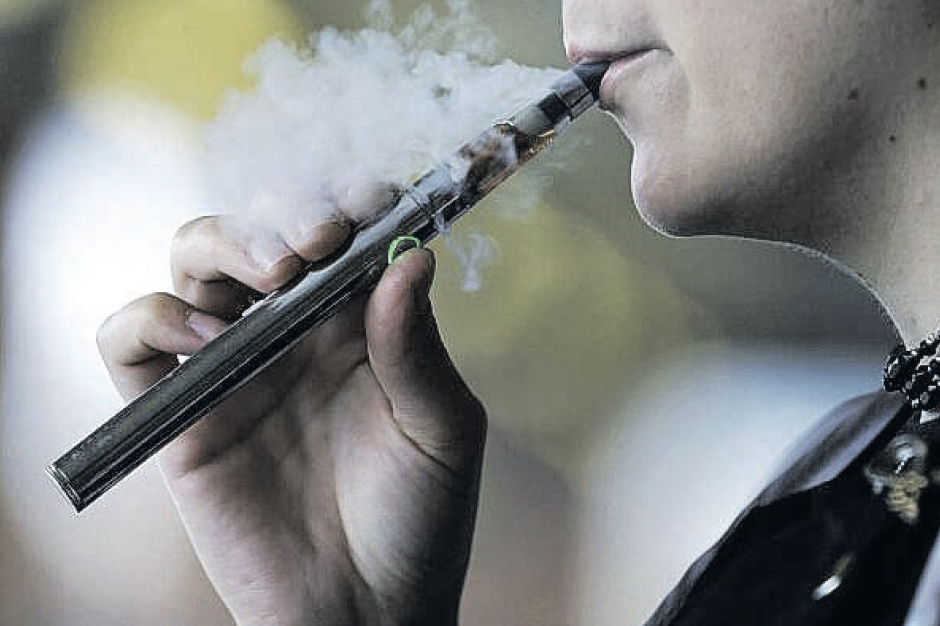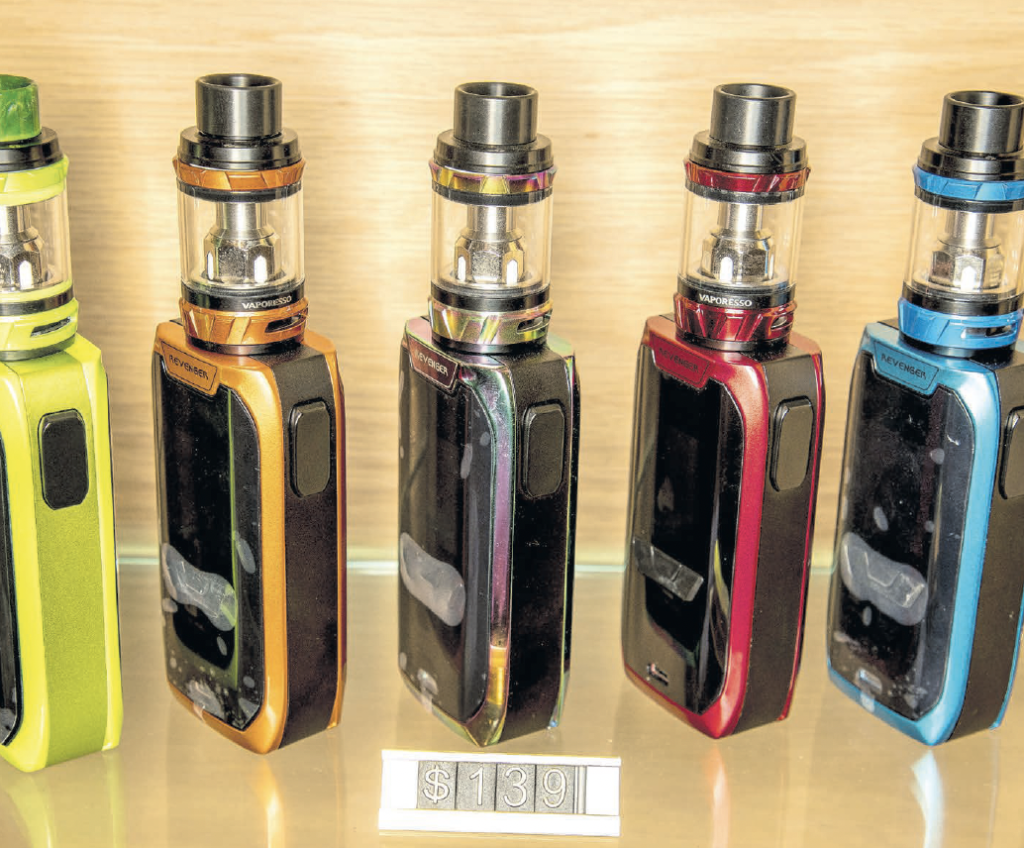Doctors warn about dangers, addiction: Is vaping safer than smoking cigarettes?

The e-cigarette was developed in 2003 by Chinese pharmacist Hon Lik as a way to help chronic smokers quit and was touted as a safer alternative to conventional cigarettes.
Over two decades later, some experts are saying it may be even more harmful than cigarettes and has become a major attraction to a demographic that was not its initial target – teens and adolescents who can become addicted to nicotine and inhale other harmful materials by using the devices.
Primary care physician Dr Vasant Basdeo has done extensive research on e-cigarettes and their effects and is disturbed by the current trend.
“To date, there has been no evidence in the medical field to suggest that the recommendation that it will help people quit is strong...And now they’ve made it so it’s kid-friendly and very popular among teens because of designs and flavours, and they promote it as if it is something very safe to do with no health consequences, and particularly targeting our young population,” he told Sunday Newsday.
Basdeo said vaping is especially harmful to this demographic for a number of reasons.
“Up until the age of 25, there is something called neuroplasticity where the pathwaves in our brain are still developing. So you can think of it as our ‘habits’ and how our conditioning of our neuro-endocrine hormonal system is. And that is just some fancy big words for ‘how does our brain react to things like stress, pleasure etc.’
“And one of the main components of e-cigarettes is the psychoactive drug, nicotine – an extremely addictive substance. This is as addictive as heroin, and I don’t think any parent would fathom the thought of their teenager being addicted to something like heroin, but here we have nicotine being propagated as a common drug without any consequences.”
Basdeo said exposure to nicotine at such a young age can have many negative consequences, among them impulsive and short emotional regulation.
“Children become a lot more angry and display a sort of aggression when they use this drug, which lasts for about an hour to two hours, is no longer in the system.
“The individual starts to feel very anxious, very uneasy and on edge, tremulous, shaky, their heart rate goes up, breathing rate goes up, blood pressure goes up, and until they get another quick dose, they feel all these symptoms. So they end up in this vicious addictive cycle.”
He said the problem of young people vaping is not exclusive to Trinidad and Tobago.

“In many other places, the demographic that has the highest use is the teenager and adolescent categories. So children from as young as eight and nine years are vaping. In 2017, just in our local setting, in the Global Youth Tobacco Survey among 13-15-year-old students, the prevalence of vaping was alarmingly higher than smoking cigarettes – around 17 per cent.
“If major countries like the UK, Australia, New Zealand and even the US are taking these rapid and drastic steps to protect their young population from the claws of addiction, we should try to do what we can here before it’s too late.
“I believe that we already missed the starting guns, but I believe we should follow in the footsteps of these countries, where they are banning the use of vapes particularly among the young population with policies on regulating the vaping industry.
According to a CDC report published last year, “a study showing an estimated 7.7 per cent of middle and high school students, or about two million in total, were current e-cigarette users in 2023... In the UK, where officials also hope to stop refillable vapes from being sold in child-friendly flavours and packaging, nine per cent of 11- to 15-year-olds reportedly use vapes.”
Globally, the sale of electronic nicotine delivery systems (ENDS), a classifier that includes e-cigarettes and vapes, has been banned in 33 countries, and another 87 countries regulate the sale of ENDS.
Earlier this month New Zealand banned the sale of e-cigarettes as a result of the rapid rise in youth vaping and raised financial penalties for those found selling the products to minors.
A recently announced plan by the UK to ban the sale of disposable vapes was among the latest efforts by countries to limit access to e-cigarettes to curb their use among children.
Basdeo is not the only medical practitioner to call for an e-cigarette sales ban.
At a virtual hearing of Parliament’s Joint Select Committee (JSC) on Social Services and Public Administration on March 20, Cancer Society chair Dr Asante Le Blanc spoke out against the advertising of vaping as something that is harmless and urged that it be banned just as tobacco advertising. Le Blanc said the fact that e-cigarettes were not included in regulations under the Tobacco Control Bill needs to be addressed.
“We need to address this because vaping has become a huge epidemic in TT. When we are allowing the advertising of vaping to our teens as something to do and a way to quit smoking when it is really a way to hook them on to smoking and other drug use...And when we are allowing ads on TV, on radio, on social media, we have a problem.”
She said it is wrong to allow the tobacco companies to say, “Don’t smoke, vape,” because there is data that proves vaping is not something safe and it contributes to non-communicable diseases.
In the 2023 Netflix docuseries Big Vape: The Rise and Fall of Juul, a lot of focus was placed on the medical and marketing sides of vaping which revealed that although the vapes were never intended for use by children, the manner in which it had been marketed and its easy access to the devices on the US market made it inevitably a go-to activity for teenagers.
Basdeo said what is also concerning is that some distributors of the devices seem not to care about the negative effects this is having on the nation’s young people.
“If you look at where these vape shops are popping up; it’s in the places that our young population frequents. Our malls, universities, near our schools, where students travel after school – all across the country.”

One parent, who didn’t want to be named, told Sunday Newsday she has had cause to confront a salesperson from whom her 14-year-old son had bought “several vaping devices over a four-month period.”
“I hadn’t a clue that my child was vaping until I found out by accident. By then he had gone through at least six disposable devices. When I found out that he had purchased it himself from a kiosk at a mall, I went crazy. How could you sell a device to a child without ID?”
Meanwhile, a teacher at a secondary school in east Trinidad told Newsday the vaping problem is not a new issue at his school.
“It has been going on for a few years, especially with students in forms three to five.
“From time to time we will try to have workshops surrounding it, we talk to the vendors, who will ultimately circumvent it because they are looking for sales.
“They will tell the students, ‘Don’t come to purchase while in school clothes,’ or ‘Come on weekends.’ In some cases, there are students selling it in school. It’s a thriving business and in some cases, parents are aware and have no issue with it because they don’t see it as smoking. It’s a challenge.”
He said when caught, students may most likely be suspended and have sessions with guidance officers.
“Sometimes we give them in-house punishment instead of suspension.”
Basdeo said it took medical practitioners many years to be able to conclude that smoking causes cancer, and although there isn’t definite evidence that e-cigarettes can be linked to cancer, there are tell-tale signs.
“Medicine is an evidence-based field. A lot of cancers are now directly linked to and caused by smoking, but with e-cigarettes, we’re basically in that guinea pig phase in the medical literature where we are waiting for concrete evidence to confidently reach any conclusion. However, we do have evidence that the contents of the e-cigarettes are things that are known carcinogens are found in them already.
“Some years ago in the US, there was this sudden increase in the number of young people ending up in the ERs with severe lung injuries, some of them having to be in ICUs and some of them not making it at all. And some of these injuries were known as vape-associated lung injuries. So there have been direct injuries associated, that vaping damages your respiratory system as well as your cardiovascular system.”
He said nicotine is naturally found in the tobacco leaf, but can now be recreated in a lab.
“What that means is that they have made it more acidic and it is much more potent. So you can have unregulated dosages of nicotine in these e-cigarettes – at a much higher concentration and dosage than what is in conventional cigarettes.
“Scientists are testing these vapes and finding things like formaldehyde, known carcinogens in these flavourants. It’s branded as fruit flavours, but there are so many preservatives and chemicals in it. And because it’s unregulated, we are clueless of the contents of the flavourants that are being added to these nicotine devices. And even more alarming is the use of petrohydrocarnabin oil, which is PHD – the part of marijuana that gets you high, so you have young minds being on these psychoactive substances at dosages and concentrations being placed in these e-liquids and being vaped into the systems of our young population.”
Additionally, he said, vaping comes with a financial cost.
“Part of my research is not just the physical effects, but the effects on life. A lot of our teenagers are still at school, so they would be using their allowance to buy these vaping devices. The cost of an average e-cigarette is between $150 and $300, and the average user takes two weeks to finish it. When you calculate that, at the end of the year you could have used that money to buy yourself something nice or even pay for a trip.”
According to a study cited by the Centers for Disease Control and Prevention, in the US monthly e-cigarette sales in the country increased from 15.5 million units in 2020 to 22.7 million in 2022.
Basdeo said as a primary care physician one of the more frightening things about vaping is that nicotine stimulates a part of the brain to produce a chemical hormone called dopamine – the pleasure or reward hormone.
“So after an hour or two passes after your fix, especially with chronic use, the brain is now craving this dopamine. This can lead to addictive behaviours with other things like conventional cigarettes, abuse or misuse of alcohol, marijuana use, and even things like gambling. Nicotine affects a part of the brain that regulates your hunger, so it suppresses hunger when you use it, so when you don’t have it in your system, you could end up binge eating, especially high sugar content foods and drinks,” leading to a host of other health problems.


Comments
"Doctors warn about dangers, addiction: Is vaping safer than smoking cigarettes?"